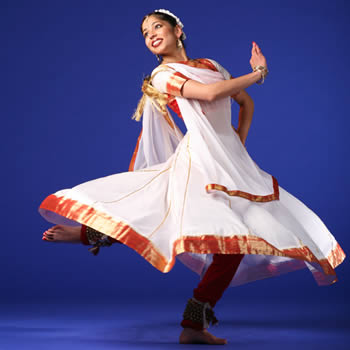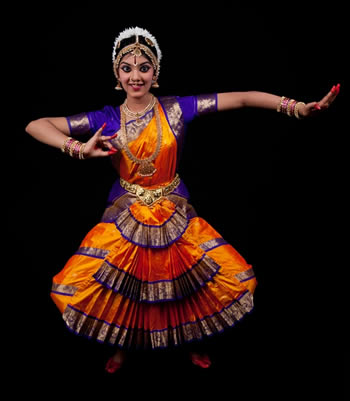Difference between Kathak and Bharatnatyam Dance
Key Difference: Kathak and Bharatnatyam are two different schools of dances. The primary difference between Kathak and Bharatnatyam Dance is the fact that Kathak originated in North India, while Bharatnatyam comes from the South.
 Kathak and Bharatnatyam are two different schools of dances. Both are forms of traditional dance that originated in India and have garnered popularity in India and outside. They started out as humble dances but have now developed into a movement with their own school. They are now taught not only in India but worldwide.
Kathak and Bharatnatyam are two different schools of dances. Both are forms of traditional dance that originated in India and have garnered popularity in India and outside. They started out as humble dances but have now developed into a movement with their own school. They are now taught not only in India but worldwide.
The primary difference between Kathak and Bharatnatyam Dance is the fact that Kathak originated in North India, while Bharatnatyam comes from the South, specifically from what is now the state of Tamil Nadu. Kathak, on the other hand, is believed to have originated in Varanasi and spread north. Today, there are three main schools, i.e. Gharanas of Kathak: Jaipur, Benares and Lucknow, named after the regions where the three distinct forms evolved.
Both dance forms started as a way to honor the gods, in fact they were performance only at temples or religious functions. Eventually, they evolved and started being performed at court and in front of audiences. While Bharatnatyam has more or less stay the same or at least similar over the years, Kathak has varied a lot. Till date Bharatnatyam is endued with religious themes and spiritual ideas, particularly of Shaivism, as well as of Vaishnavism and Shaktism. However, Kathak deviated from this into a form of pure story telling. It started by telling stories of the gods, such as storied from Ramayana and Mahabharata, but then started tells other stories as well purely for entertainment factor. The main reason for this that while Bharatnatyam continued to be performed at temples, Kathak was adopted by traveling bards and storytellers who travelled from village to villages telling stories.
Both these dances, along with other classical Indian dances declined during the colonial British rule in the 19th century. These dance practices were denounced by colonists and Christian missionaries who dehumanized the women dancers calling them “nautch-girls.” The Wrongs of Indian Womanhood, published at the start of the 20th century, cited the seductive gestures and facial expressions used in these dances as evidence of "harlots, debased erotic culture, slavery to idols and priests" tradition. The dancers were labeled as prostitutes and the dances as a front for prostitution despite of no evidence other than cultural prejudice.
 There was eventually a ban in 1910 on all Indian classical dances. Indians cried out against this ban afraid that their identities were being repressed. Afraid that these dance forms as well as other traditional practices would die out, a massive revival was put into practice eventually leading these dances back into popularity, one that steadily increased after Indian Independence.
There was eventually a ban in 1910 on all Indian classical dances. Indians cried out against this ban afraid that their identities were being repressed. Afraid that these dance forms as well as other traditional practices would die out, a massive revival was put into practice eventually leading these dances back into popularity, one that steadily increased after Indian Independence.
In terms of the dances themselves, they differ in some significant manner. whereas in bharatnatyam the focus is on the hasta mudras, i.e. hand formations as well as facial expressions.
The costumes that are worn for the two dance styles also differ. In Bharatnatyam, the outfits are more intricate and heavy. Most women dancers wear form fitted silk saris that are pleated in the front to look like a large hand fan during the dance. These are often paried with heavy traditional jewelry, with full make up, and Ghungroos. In Kartak, the dresses are less complicated withless heavy jewelry and make up, but are paired with Ghungroos. A dancer may wear a sari or a long skirt with a blouse and an orhni (scarf). In the Lucknowi Kartak, women often wear a long skirt with close fitting churidar pyjamas and sometimes a long coat covering hands and the upper body, and a head covering orhni. Men may wear a dhoti paired with a silk scarf. The chest may be bear or covered with an open vest jacket. Also, men kartak dancers are quite common, whereas they are less common in bharatnatyam which is more commonly practiced by women.
Another difference is the fact that while a single performance of Kathak is divided into 3 segments, each performance of Bharatnatyam is divided into 7 segments. Kathak is divided into the invocation (of God or Guru), one pure (abstract) dance recital called nritta and one expressive dance called nritya which is slower and more expressive in nature. Bharatnatyam is divided into Alarippu (the invocation), Jatiswaram (which adds melody to the nritta), Shabdam (adds words), then Varnam (more complicated nritya), Padam (reverence, simplicity, bhakti), and finally the Thillana (climax, finale).
Comparison between Kathak and Bharatnatyam Dance:
|
|
Kathak |
Bharatnatyam |
|
Existed since |
Can be traced back to 2nd century BC but has changed over the years. |
2nd century CE |
|
Etymology |
From Sanskrit katha meaning “story, conversation, traditional tale”. |
Bha stands for bhava (feelings, emotions), ra stands for raga (melody, framework for musical notes), and ta stands for tala (rhythm). Natyam is Sanskrit for “dance”. |
|
Also known as |
|
Sadir, Daasiyattam |
|
Transcribed in |
Written in Natya Shastra compilation by ancient scholar Bharata Muni, dated to between 200 BCE and 200 CE |
Written in Natya Shastra compilation by ancient scholar Bharata Muni, dated to between 200 BCE and 200 CE |
|
Passed down as |
An oral tradition, learnt and innovated from one generation to another verbally and through practice |
Teachings from masters to students in various dance schools. |
|
Region |
North India |
South India |
|
Developed in |
Varanasi and passed north |
Tamil Nadu |
|
Originally Performed in |
Courts and for public viewing |
Temples |
|
Function |
Storytelling – Performance Dance |
Reverence of God through dance and performance |
|
Schools |
3 Gharanas: Jaipur, Benares and Lucknow |
Too many depending on individual teachers |
|
Focuses on |
Dancing and acting. Pure movement. Lucknow style emphasizes acting, while Jaipur style emphasizes the dance and footwork. |
Dancing and is strict in its form |
|
Expresses |
Tells a story, originally stories about the gods, then eventually purely entertaining stories Jaipur gharana focuses on religious themes and spiritual ideas based in Vaishnavism and Shaivism. |
Hindu religious themes and spiritual ideas, particularly of Shaivism, but also of Vaishnavism and Shaktism |
|
Performed by |
Both men and women |
Typically women |
|
Form |
A standing form with legs and torso typically straight |
Bent knee form called ara mandi, a half sitting position |
|
Emphasis on |
Footwork |
Hasta mudras or hand formations |
|
Expressions |
Kathak expressions are more introverted and withdrawn |
Bharatanatyam expressions are more extroverted and expansive |
|
Noted Style |
Rhythmic foot movements, adorned with small bells (Ghungroo), and the movement harmonized to the music and incorporating gestures of arms and upper body movement, facial expressions, stage movements, bends and turns. |
Fixed upper torso, legs bent, spectacular footwork, and sophisticated sign language based on gestures of hands, eyes and face muscles. |
|
Consists of |
Various hand and foot movements, with the focus on the footwork. |
64 basic 'Adavu' (steps) that are divided into nine parts, in addition to 'Hasthamudra' (hand gestures) |
|
Costume |
Hindu Variation: Sari or skirt, with blouse called choli, and orhni (Scarf) Muslim Variation: skirt with close fitting churidar pyjamas and sometimes a long coat covering hands and the upper body, with a head cover scarf |
Resembles Tamil Hindu's bridal dress, made up of Paijama and jacket of Kanchipuram silk and Banaras silk. Consists of tailor fitted brilliantly colored Sari, with a special pleated cloth stitched that falls in front and opens like a hand fan during the dance. |
|
Ornaments |
Anklets adorned with small bells (ghungroo) and light jewelry |
Heavy traditional jewelry with ghungroo and heavy makeup. |
|
Music |
Can vary depending on the preference of the performer |
Carnatic classical music |
|
Instruments |
Two to twelve classical Indian instruments or more in each performance, including tabla, sarangi or harmonium with manjira, |
Bansuri, Dilruba, Esraj, Ghungharu, Harmonium, Pakhawaj, Santur, Sarangi, Sarod, Sitar, Surmandal, Tabla, Tanpura, Veena, Flute, Mridangam, and Violin. Accompanied by a singer. |
|
Sections |
Three main sections - the invocation (of God or Guru), one pure (abstract) dance recital called nritta and one expressive dance called nritya which is slower and more expressive in nature. |
Seven-part order of presentation: Alarippu (invocation), Jatiswaram (adds melody to nritta), Shabdam (adds words), Varnam (more complicated nritya), Padam (reverence, simplicity, bhakti), Thillana (climax, finale) |
Reference: Wikipedia (Kathak and Bharatnatyam), Cultural India (Kathak and Bharatnatyam), CyberKerala Image Courtesy: fromwithinacademy.com, kathak.org









Add new comment